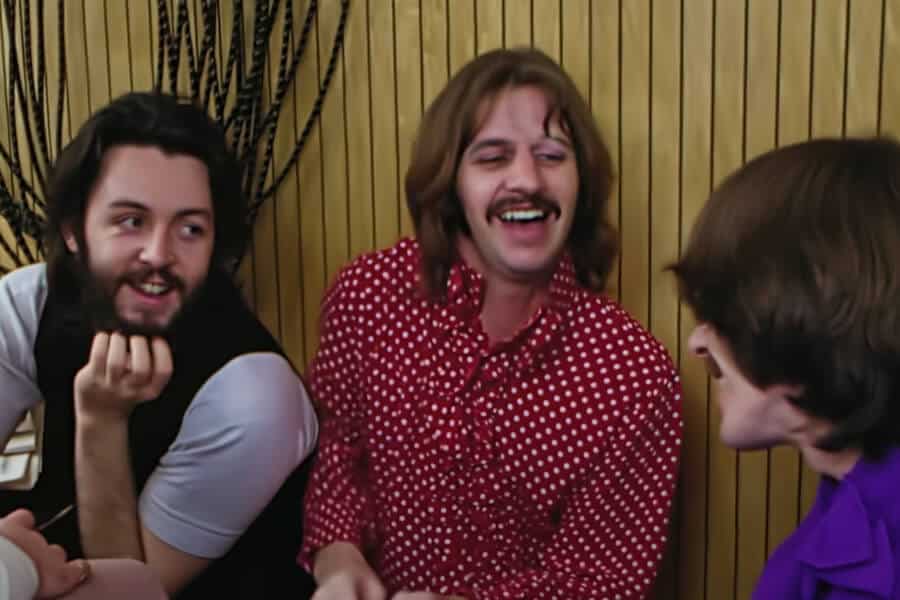When the album Beatles ’65 came out, Mary, my neighbor, rushed to my house to play it on my brother’s “stereo,” a crude record player with two speakers trailing out from either side of it. Over and over, we listened to “I Feel Fine” and “I’m a Loser” until we could sing them all the way through. I was just six years old, but Mary was 11, my “cool” next door neighbor who had taught me to love the Beatles.
My sister told me to love Ringo because all the other Beatles were taken. So I did.
I was too young for Beatlemania, really, but Mary, five years my senior, used to bring over her Tiger Beat and 16 magazines and we’d page through each issue. At her knee, I was the student as she schooled me in the names of each Beatle, his wife or girlfriend, and various other facts about them. She loved Paul, of course, which meant that he was off-limits to me as my first celebrity crush. One of her best friends had claimed John while another had designs on George. “You should love Ringo,” she told me. So I did.
I also ingested the Ed Sullivan show appearances, dutifully saw “A Hard Day’s Night” and “Help” several times in the local movie theater, and hung a black-and-white picture of Ringo, pulled from a Tiger Beat magazine, on my bedroom wall. I even had a pink wallet from which the Fab Four looked back at me, my dime, nickel and three pennies carefully placed into the coin slots it afforded me.
Read More: The Real Story Behind `Killing Me Softly’ That Unites Roberta Flack and Lori Lieberman
Later-Stage Beatles
While those days seem so vivid in my memory, they passed quickly. Mary got older and so did I. We no longer spent our days in a bliss of Beatles pictures, music, and trivia. She started dating real boys, and I got distracted with the Monkees. But the Beatles didn’t go away. My older brother got married in the summer of 1968, when I was just nine years old, and I loved to go to his apartment. On his navy blue, crushed velvet couch, I would curl up while he played the latest albums on his (much better) stereo. Once, he played me the newest Beatles album—Sgt. Pepper’s Lonely Hearts’ Club Band. I remember that I didn’t love the lads’ longer hair or some of the more “psychedelic” songs like “Within You Without You” or even, at first, “Lucy in the Sky With Diamonds.”
At a certain point, Beatles music became the aural wallpaper of my life.
But I still found the Beatles clever. As I read the lyrics on the record sleeve, I felt a need to share. “Listen to this,” I said to my brother and new sister-in-law, “`Lovely Rita, Meter Maid, nothing can come between us. When it gets dark I tow your heart away.’ Get it?”
At a certain point, though, Beatles music became the aural wallpaper of my life. The Beatles were no longer making news every day or shocking us with their long hair. And frankly, their trips to India seemed a little weird. I sang along to “Get Back,” “Hey Jude,” and “The Long and Winding Road.” But these songs lacked the excitement that erupted back just a few years earlier when the sound of screaming young girls who couldn’t get enough drowned out the actual music played by the band.
Watching Genius
Which is why the new Beatles documentary, The Beatles: Get Back, is so remarkable to me. It’s nearly eight hours long and, to be frank, at times tedious. After about 90 minutes, my husband bailed. “I can’t watch this anymore,” he said as he headed to bed. But I was transfixed.
In my lifelong connection with the Beatles, I had never bothered to think about how their hundreds of songs got written, or the collaboration between them, or the sheer creativity that oozed out of them. To me, the song “Get Back” just happened. But the film made me understand the birth of such classics in a way I’d never really grasped, let alone thought about.
The documentary made me understand the birth of some classic Beatle songs.
To watch McCartney again and again play a little lick of music that would eventually become “Get Back” is to understand the art that goes into creating a pop music phenomenon. To see him and George Harrison bicker and ultimately collaborate is to understand that producing such music takes not only talent but cooperation, diplomacy, and—sometimes—humor. Director Peter Jackson has also demonstrated what all of us who’ve ever tried to do something creative know all too well—it can take hours of false starts (for a little while, McCartney thought “Get Back” would be a song about the hatred of immigrants), repetition and practice (How many times are they going to play “Don’t Let Me Down?”), and sometimes, a little help from friends (Billy Preston’s keyboards play an outsized role in making “Get Back” come together—to use some Beatles language).
As a 60-plus-year-old woman, I am, by all measures, an adult. Yet I emerged after watching this documentary for nearly eight hours over three days feeling that I’d finally grown up when it came to the Beatles. And that was a good thing. Because although I will forever remember and treasure those innocent days of fanzines, twisting to “Twist and Shout” in my basement, and singing “I Wanna Hold Your Hand” at the top of my lungs, I suddenly understood more deeply that the soundtrack of my young life was born of real toil, real creativity, and real talent. And knowing that made me appreciate the Beatles all over again. Thanks to Peter Jackson, I will never again listen to a Beatles song in exactly the same way.





















0 Comments